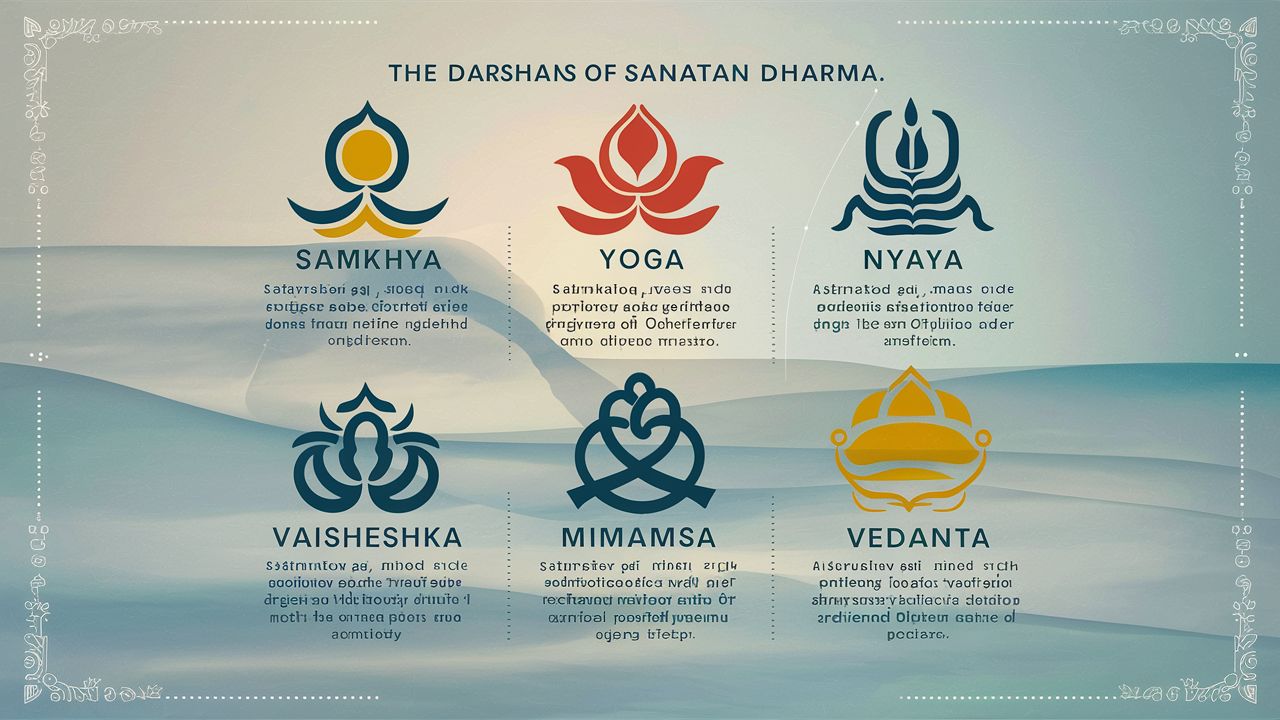In Sanatan Dharma (Hinduism), there are six major schools of philosophy, also known as "Shad Darshanas," are Samkhya, Yoga, Nyaya, Vaisheshika, Mimamsa, and Vedanta each offering distinct perspectives on the nature of reality, existence, and the path to spiritual liberation.

These six schools of thought are:
1. Nyaya Darshana: Nyaya is a school of logic and epistemology, founded by sage Gautama (also known as Akṣapāda). It focuses on logical reasoning, analysis, and inference as the means to attain valid knowledge (pramāṇa). Nyaya philosophy outlines various methods of logical reasoning, including inference (anumāna), analogy (upamāna), and perception (pratyakṣa).
2. Vaisheshika Darshana: Vaisheshika, attributed to the sage Kanada, is a school of metaphysics and atomism. It explores the nature of the universe, proposing that all physical objects are composed of atoms (anu) and that the interaction of these atoms gives rise to the diversity of the material world. Vaisheshika philosophy also discusses categories of existence (padārtha) and the concept of liberation (moksha).
3. Sankhya Darshana: Sankhya, attributed to sage Kapila, is a school of philosophy that delves into metaphysics, cosmology, and psychology. It elucidates the duality of Purusha (consciousness) and Prakriti (matter) as the foundational principles of existence. Sankhya philosophy outlines the process of evolution (parinama) and the path to liberation through discerning the self (atma-viveka) from material nature.
4. Yoga Darshana: Yoga, as expounded by sage Patanjali, is a spiritual practice aimed at attaining union with the divine. The Yoga Sutras delineate the eightfold path (Ashtanga Yoga) consisting of ethical precepts (yamas and niyamas), physical postures (asanas), breath control (pranayama), sense withdrawal (pratyahara), concentration (dharana), meditation (dhyana), and absorption (samadhi). Yoga philosophy emphasizes self-discipline, self-awareness, and inner transformation.
5. Mimamsa Darshana: Mimamsa, attributed to sage Jaimini, is a school of Vedic hermeneutics and ritual interpretation. It focuses on elucidating the meaning of Vedic texts (shruti) and the performance of rituals (karma-kanda) prescribed therein. Mimamsa philosophy emphasizes the importance of dharma (righteous duty) and adherence to scriptural injunctions for spiritual merit (punya).
6. Vedanta Darshana: Vedanta, also known as Uttara Mimamsa, is a school of philosophy based on the Upanishads and the Brahma Sutras. Vedanta expounds the non-dualistic (Advaita), qualified non-dualistic (Vishishtadvaita), and dualistic (Dvaita) interpretations of the ultimate reality (Brahman) and the individual self (Atman). Vedanta philosophy emphasizes self-realization, devotion (bhakti), and the dissolution of ego to attain liberation (moksha).

These six darshanas offer diverse perspectives on the nature of existence, reality, and the path to spiritual enlightenment, providing seekers with rich philosophical frameworks to explore and comprehend the mysteries of life.
Thank you, if you like please share !!
What are Darshans?